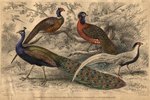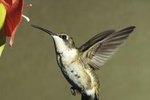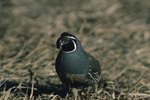
Look down to see quail, because this stout little bird doesn't fly too well. That's OK because she's a fast runner. Most everything this game bird needs is down low, including food and nesting locations. When it's time to nest, mom or dad will locate the ideal location to brood the eggs.
Down Low, Blending In
There are several species of quail in North America, all of which keep to the ground during the course of the day. Their colors -- usually a brown or gray with black, white or chestnut accents -- allow quail to blend in to their habitat. It's nice to have quail in your yard because they'll help keep it free of insects and weed seeds.
Montezuma Quail
The Montezuma quail is found mostly in the southwestern part of the country. She keeps to elevations around 3,000 feet, making her home in savannas or woodlands. The hen has more brown coloring than the male, who has a striking black and white pattern on his face. This quail nests anytime between late June through August, using grass to weave a nest. Mom and dad help in the incubation process, with both taking turns sitting on the nest. It's normal for the Montezuma quail to lay a clutch of approximately 10 eggs once a year.
Scaled Quail
Named for his scaled appearance on his chest, neck and belly, this bird enjoys life in the southwestern states. Her range extends up to 7,000 feet in elevation and includes open plains, mesas, sagebrush, some woodlands and hills. When it's time to nest, she'll look for a ground spot in dense vegetation, such as desert shrubs, small bushes and yucca plants. The hen and male build the nest, which is a 3 inch deep depression lined with leaves and grass stems, about 9 inches across. The nest will hold the clutch of 10 to 13 eggs, which take about three weeks to hatch. This hen usually lays once a year, but may have two broods in a year.
Gambel's Quail
Another quail in the southwestern U.S. is Gambel's quail, a bird with various light-colored markings on her chestnut sides and olive wings. The male of the family has a black face, neck and patch on his breast. This game bird likes thorny, brushy vegetation in warm deserts, as well as desert mountain foothills and mesquite springs. The desert shrubbery provides protection from predators as well as nesting opportunities. Occasionally a tree with a good base will serve as a nesting spot, as high as 30 feet off the ground. The nest, made of grass stems, leaves, feathers and twigs, is 1.5 inches deep and about 6 inches in diameter. The average clutch size is 10 to 12 eggs, incubating about three weeks before hatching. The Gambel's quail hen lays eggs once a year.
Northern Bobwhite
The Northern bobwhite covers more ground than his southwestern-based relatives, living in a large portion of the U.S., ranging from the Midwest to East Coast. Grasslands, agricultural fields, rangelands and pine forests are attractive to this bird. The bobwhite sports an intricate pattern of reddish-brown, brown, black and buff, with the male showing a black and white head pattern. Like other quail, the male and female of this species work together to make a nest, digging a depression in the ground about 2 inches deep and 6 inches across. After lining it with grass and other vegetation, the pair usually weaves an arch of grasses and weaves to hide the nest. This species of quail has a short life span compared to other species, however, its ability to have two or three broods in a year helps their numbers. The average clutch size is 12 eggs, taking about three weeks to hatch.
Mountain Quail
Few people get to see the elusive mountain quail, confined to the foothills and mountains of the western U.S. The male and female have gray heads and breasts, chestnut bellies marked with white bars and maroon throats. Unlike other quail, this bird may live at high elevations, reaching up to 9,000 feet, though she'll walk to lower elevations in the fall. For mating, the mountain quail likes dense vegetation, particularly in forests. Nests are shallow indentations in the ground, lined with pine needles, feathers, leaves and grass and hold a clutch of 10 to 12 eggs, laid once a year.
References
- Cornell Lab of Ornithology: All About Birds: California Quail
- Animal Planet: Quail
- Birds of North America: Quails
- Animal Diversity Web: Callipepla gambelii Gambel's Quail
- Animal Diversity Web: Cyrtonyx montezumae Montezuma Quail
- Cornell Lab of Ornithology: All About Birds: Northern Bobwhite
- Audubon.org: Mountain Quail Oreortyx pictus
- Cornell Lab of Ornithology: All About Birds: Scaled Quail
- U.S. Department of Interior Bureau of Land Management California: Mountain Quail Oreortyx pictus
Photo Credits
-
Jupiterimages/Photos.com/Getty Images




